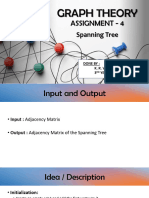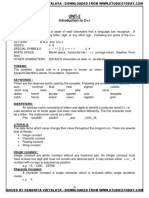0% found this document useful (0 votes)
10 views8 pagesPRIMs Concept Program Tracing
Prim's Algorithm is a greedy method for finding the minimum spanning tree of a weighted undirected graph by starting from a single vertex and adding the smallest edge connecting the tree to a new vertex until all vertices are included. It utilizes data structures like a priority queue and an adjacency list for efficient implementation, with time complexities varying based on the graph representation. The algorithm successfully avoids cycles and outputs the total weight of the minimum spanning tree.
Uploaded by
rvit23bcs098.rvitmCopyright
© © All Rights Reserved
We take content rights seriously. If you suspect this is your content, claim it here.
Available Formats
Download as PDF, TXT or read online on Scribd
0% found this document useful (0 votes)
10 views8 pagesPRIMs Concept Program Tracing
Prim's Algorithm is a greedy method for finding the minimum spanning tree of a weighted undirected graph by starting from a single vertex and adding the smallest edge connecting the tree to a new vertex until all vertices are included. It utilizes data structures like a priority queue and an adjacency list for efficient implementation, with time complexities varying based on the graph representation. The algorithm successfully avoids cycles and outputs the total weight of the minimum spanning tree.
Uploaded by
rvit23bcs098.rvitmCopyright
© © All Rights Reserved
We take content rights seriously. If you suspect this is your content, claim it here.
Available Formats
Download as PDF, TXT or read online on Scribd
/ 8























































































